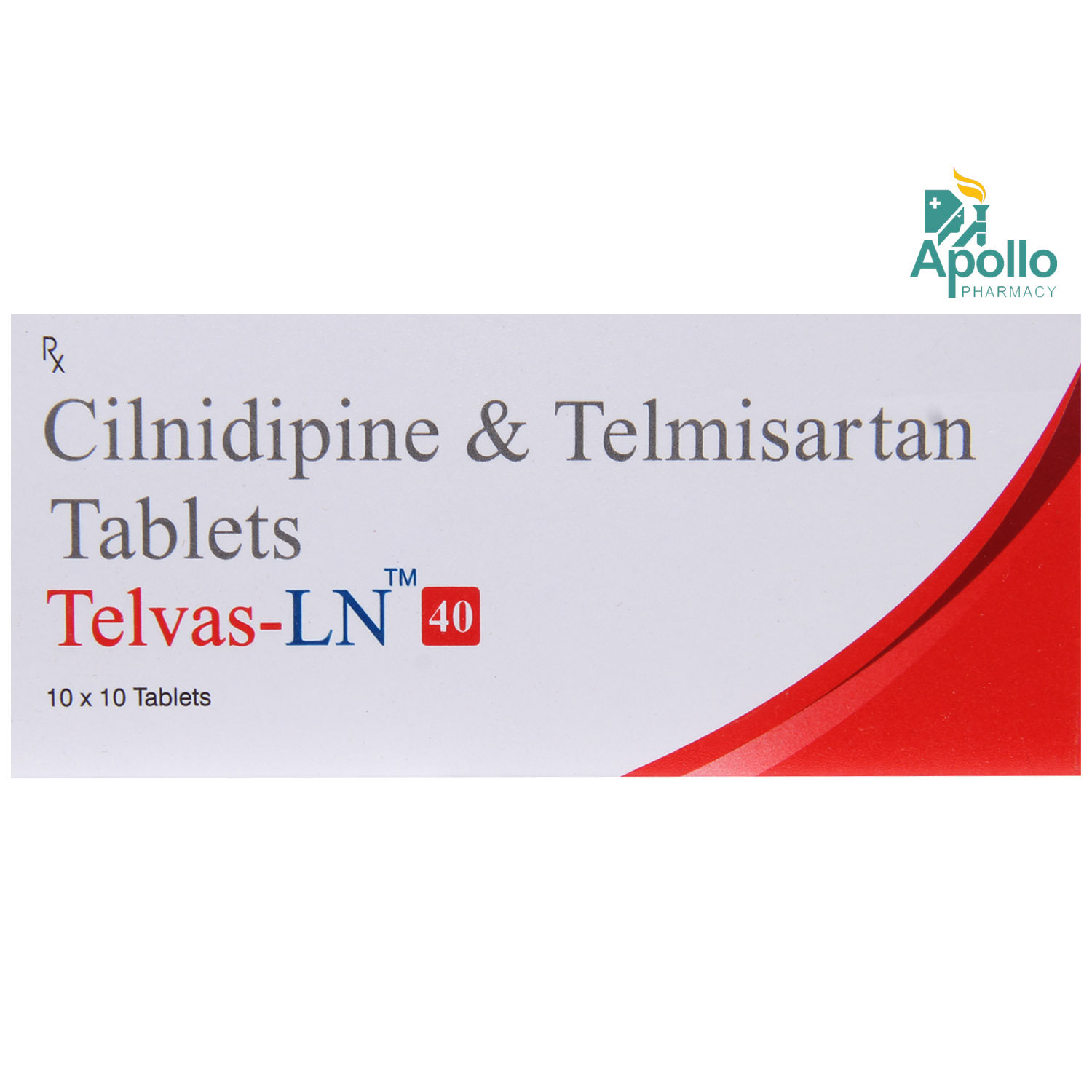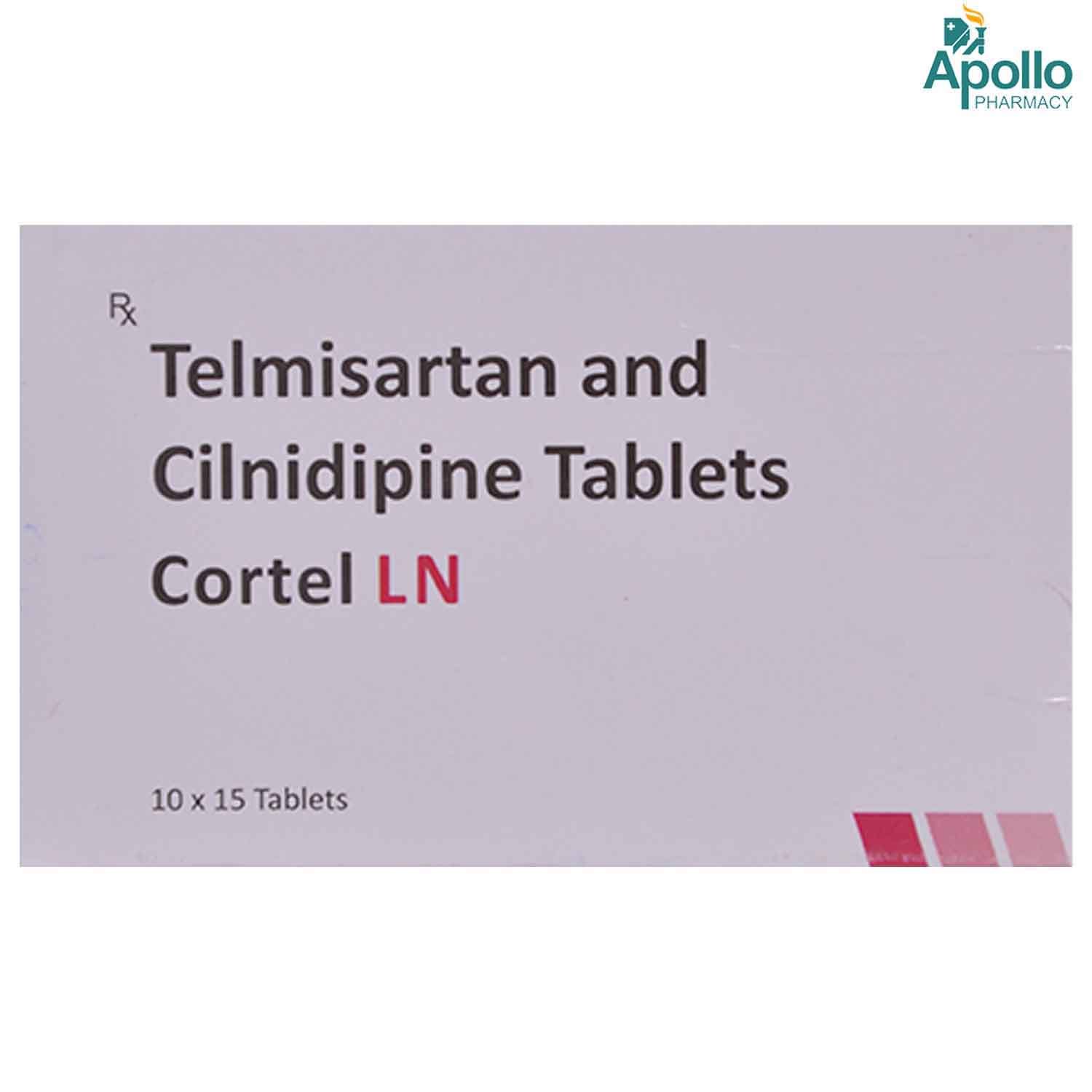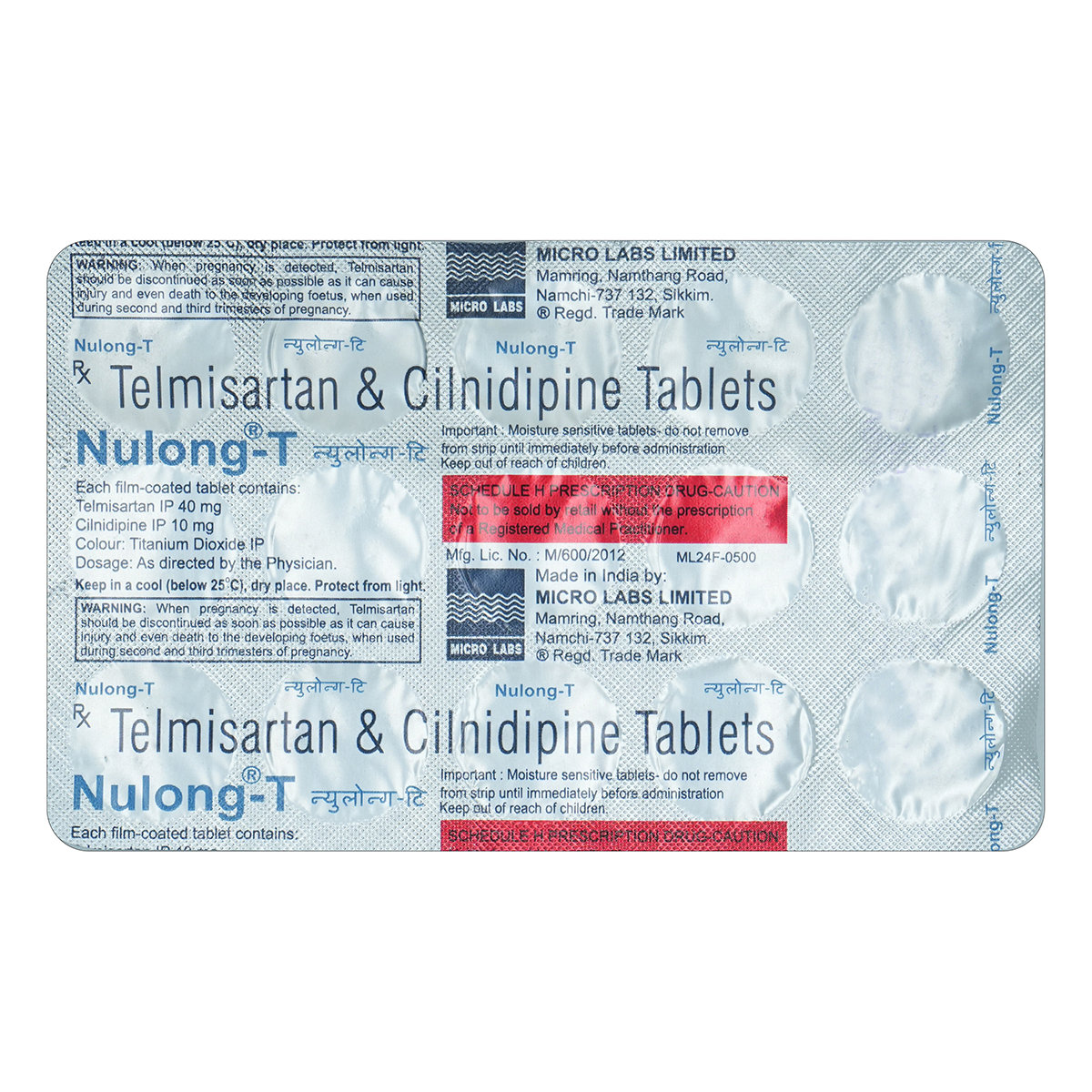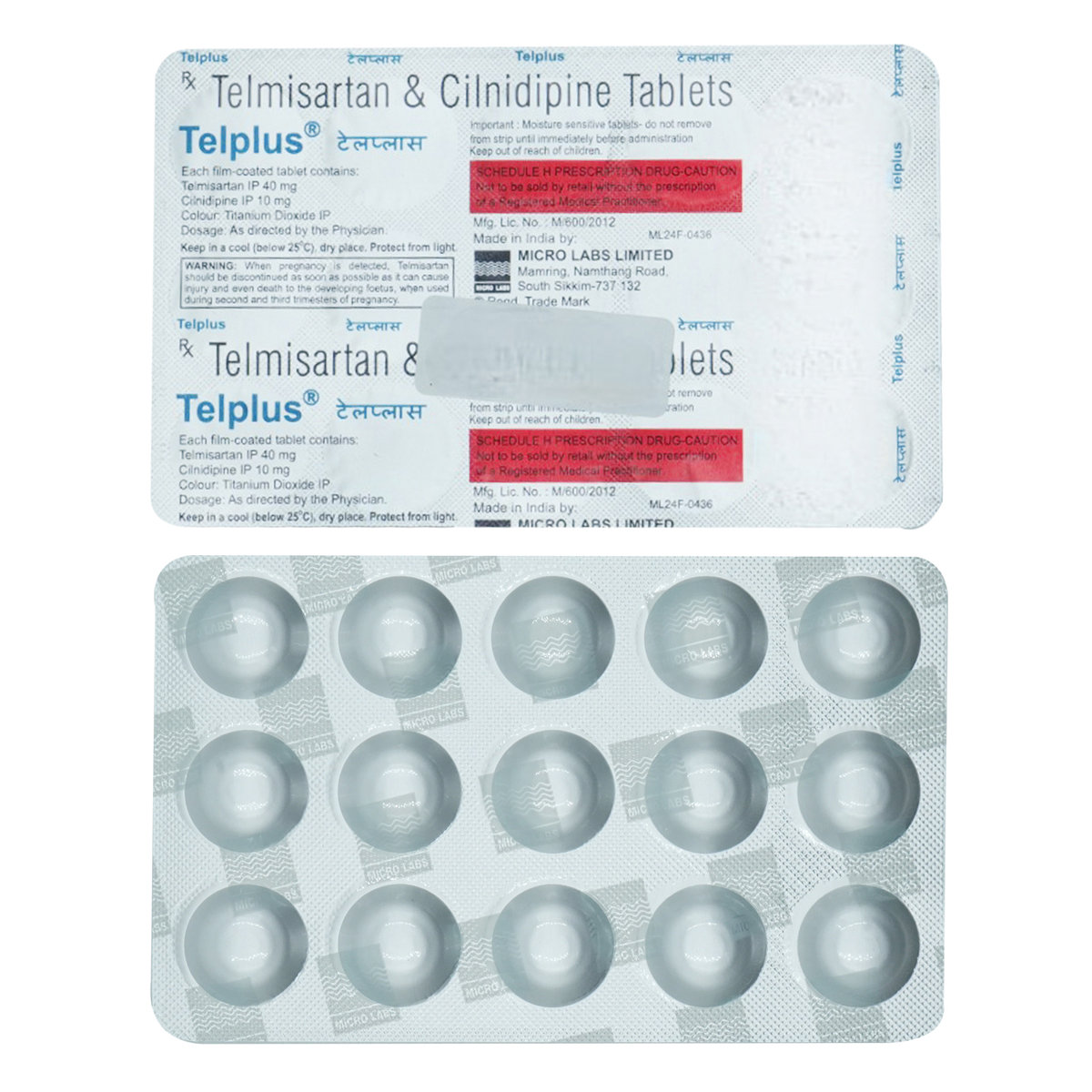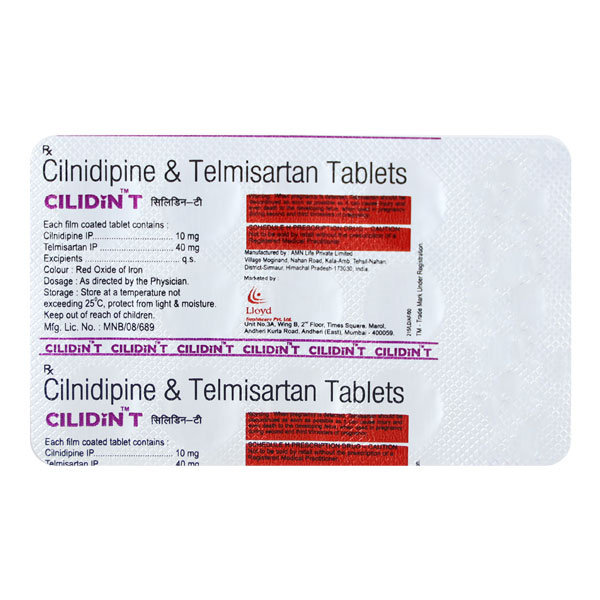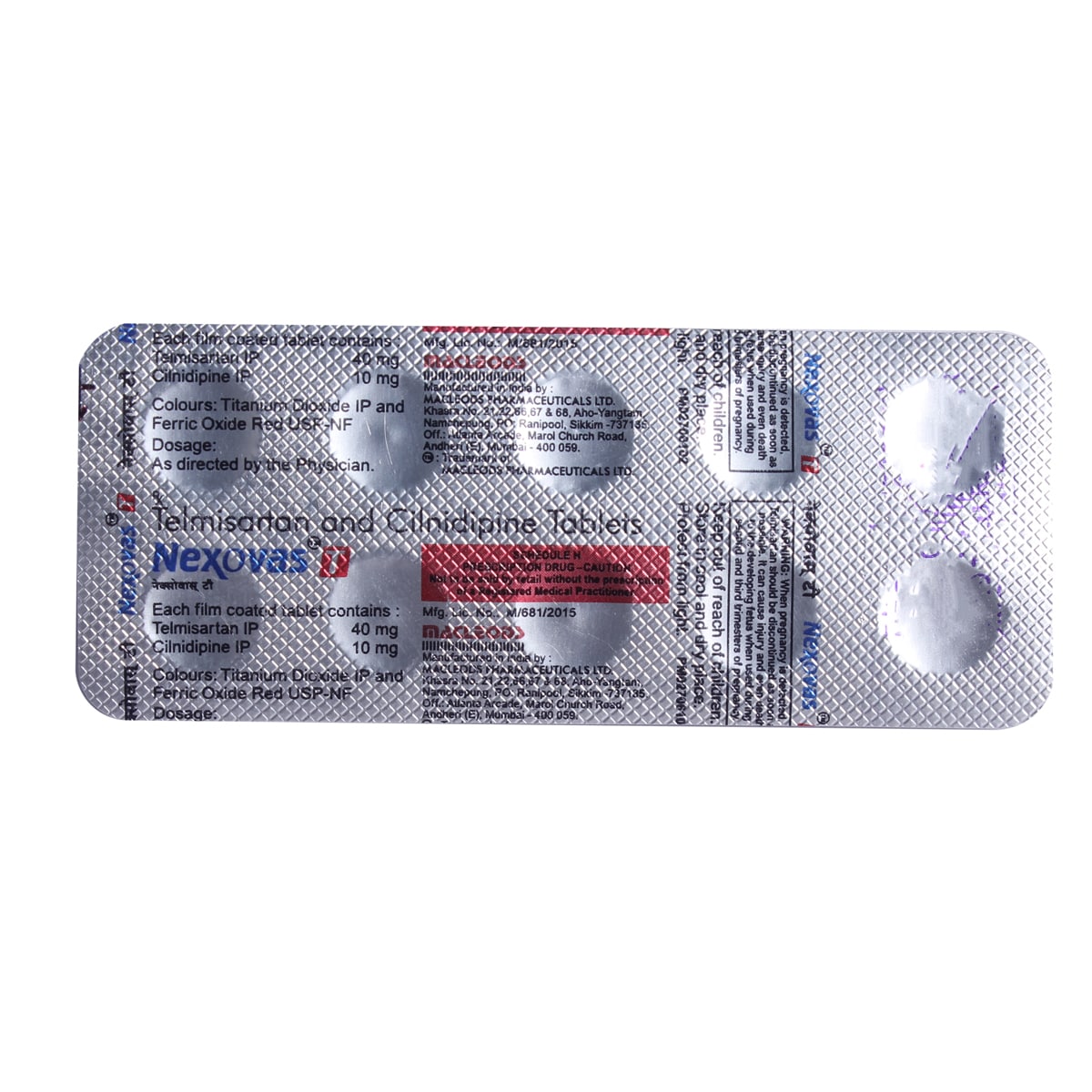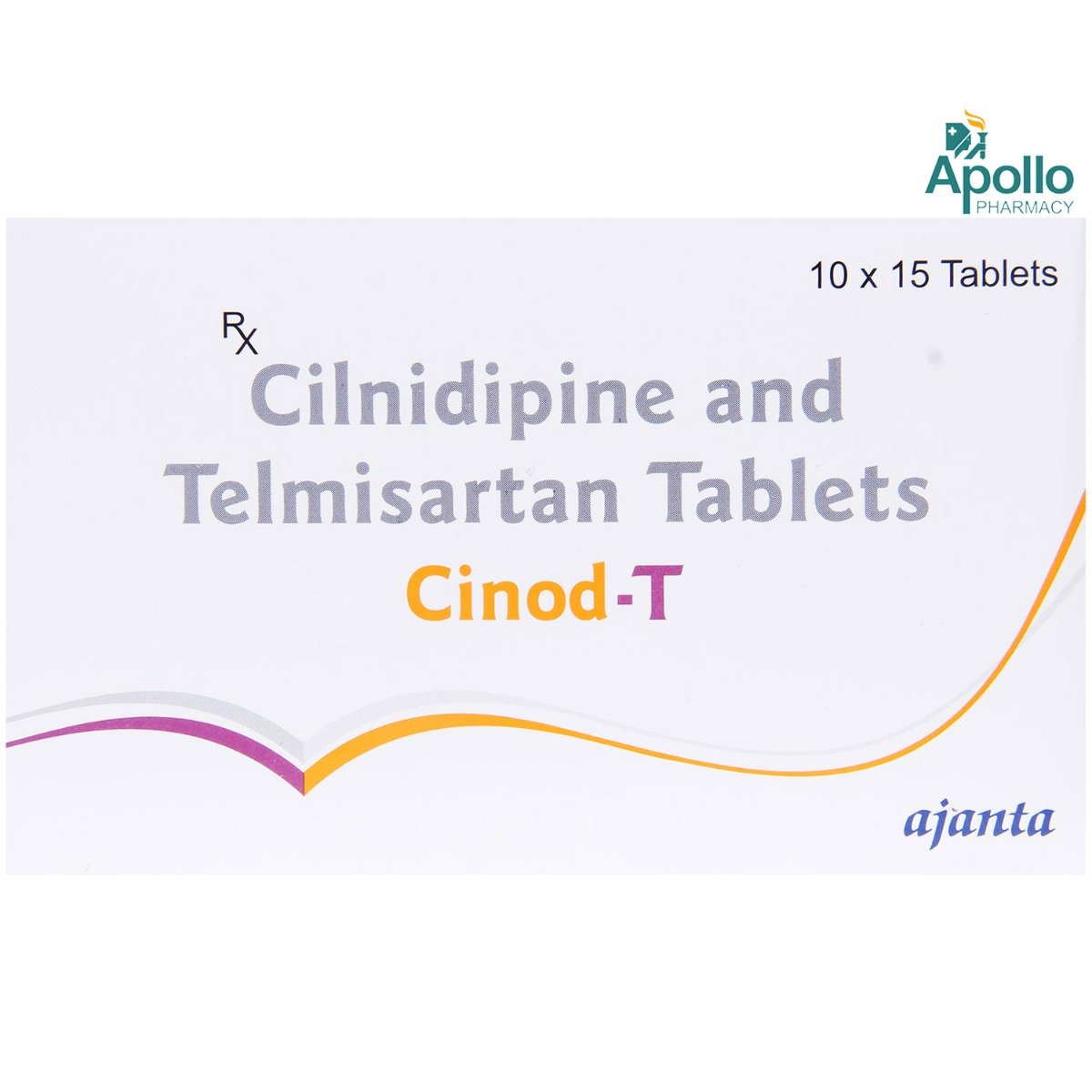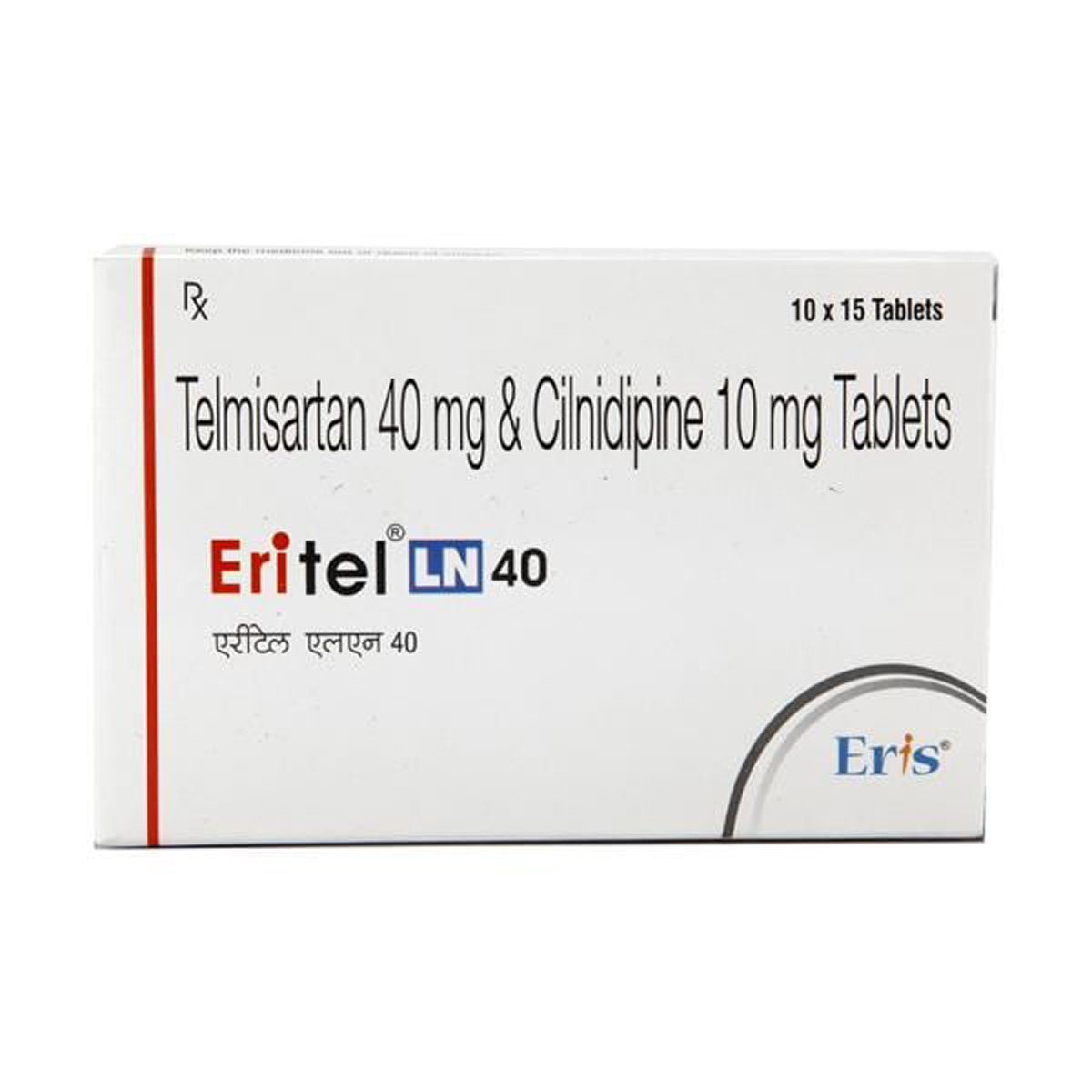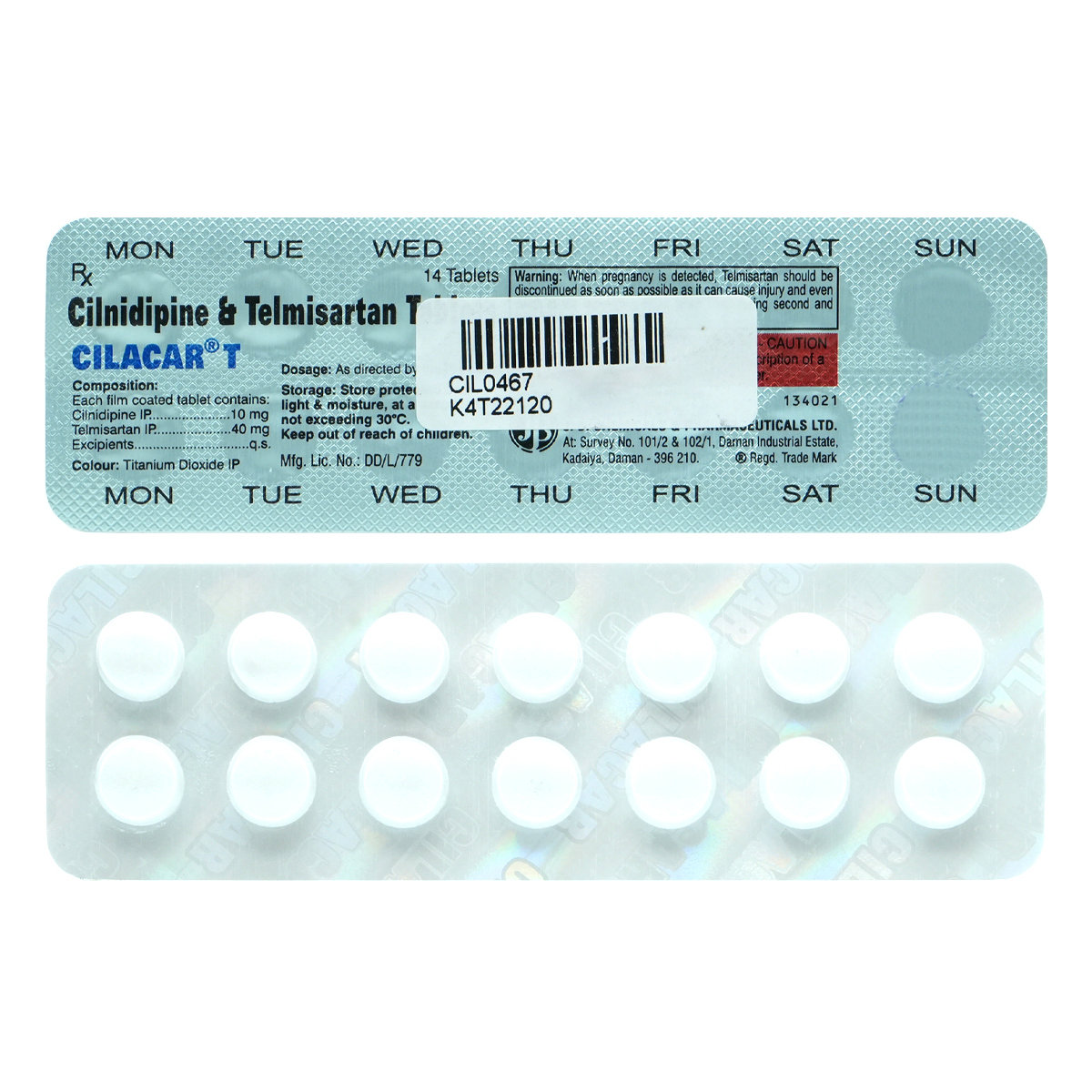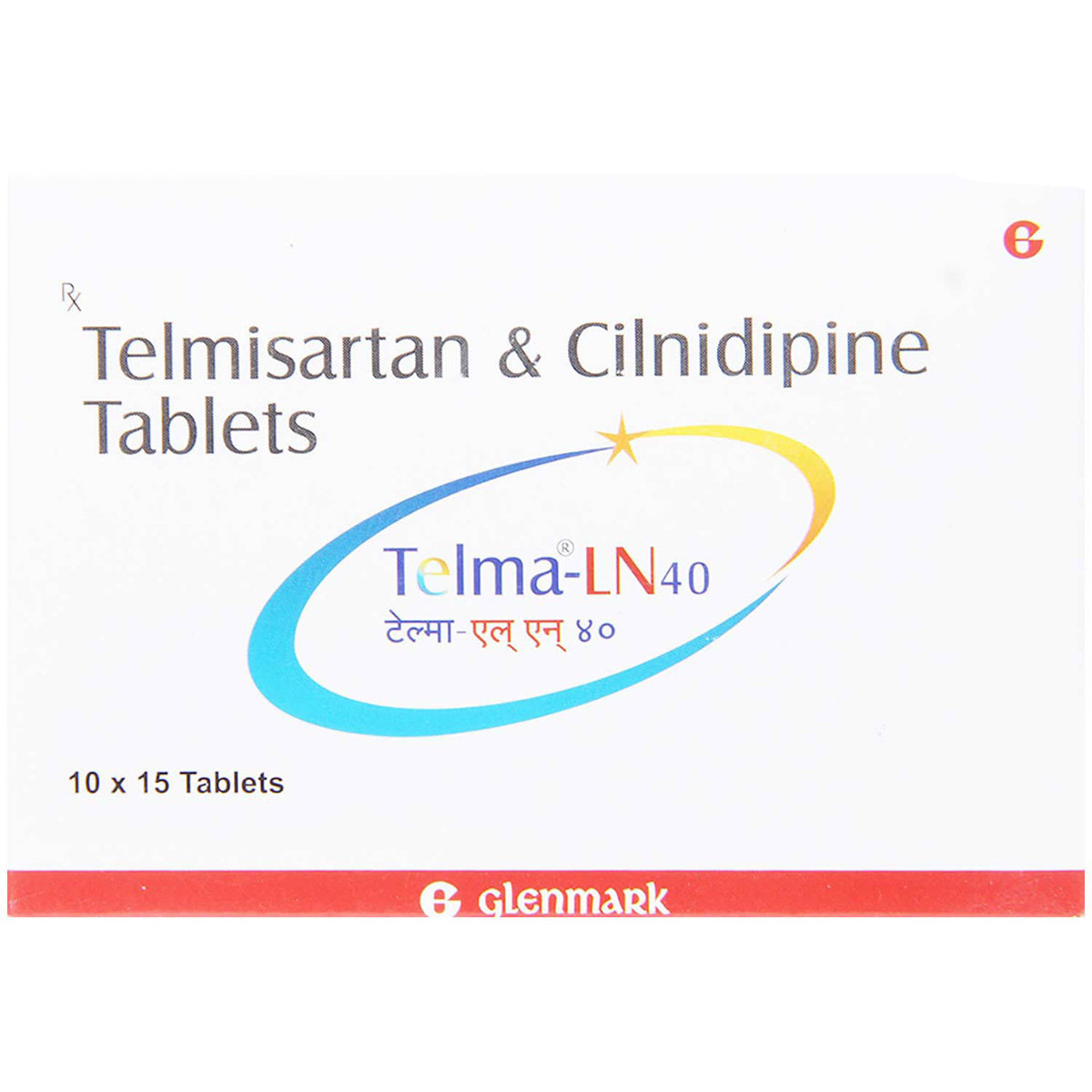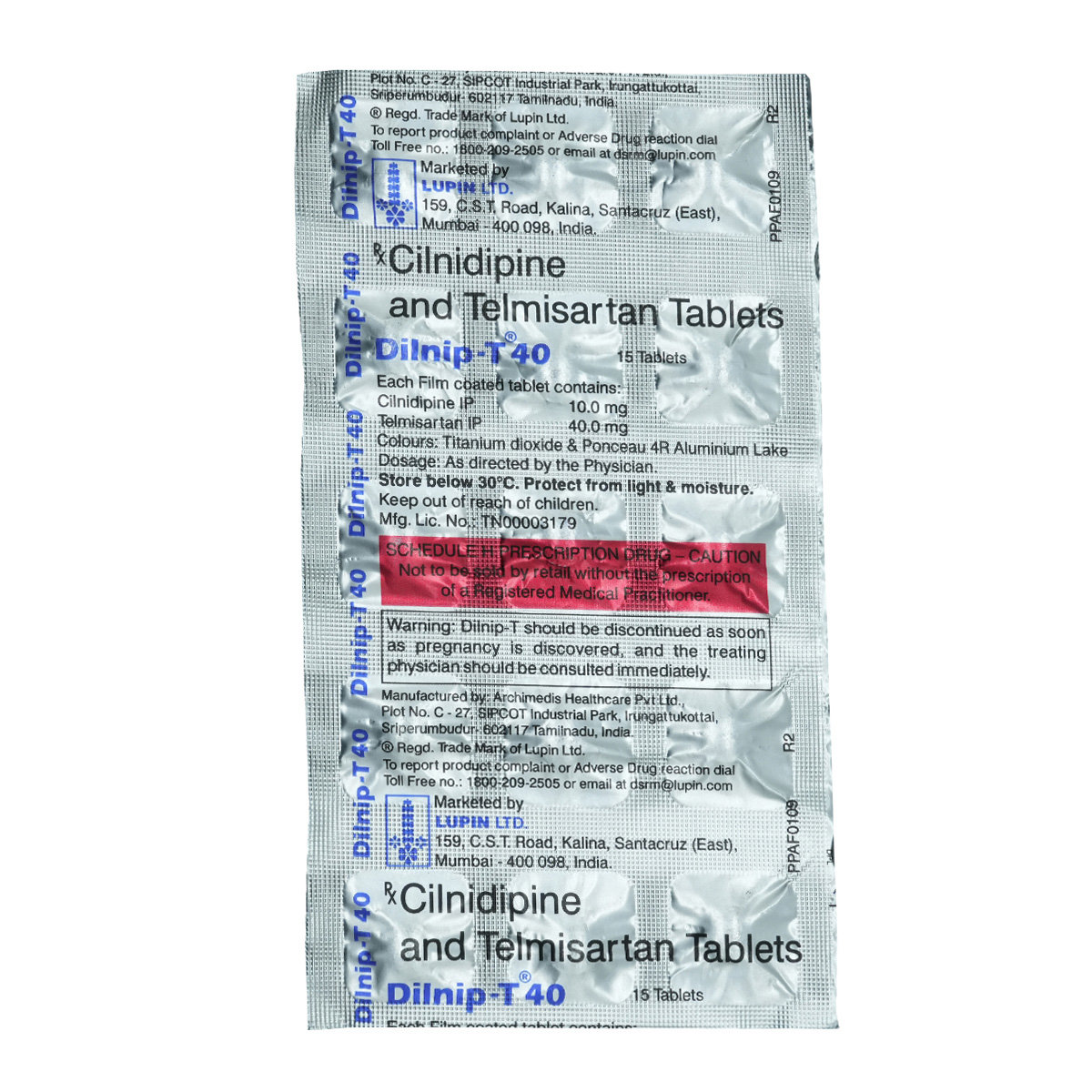Cilaheart-T 10 mg/40 mg Tablet 15's


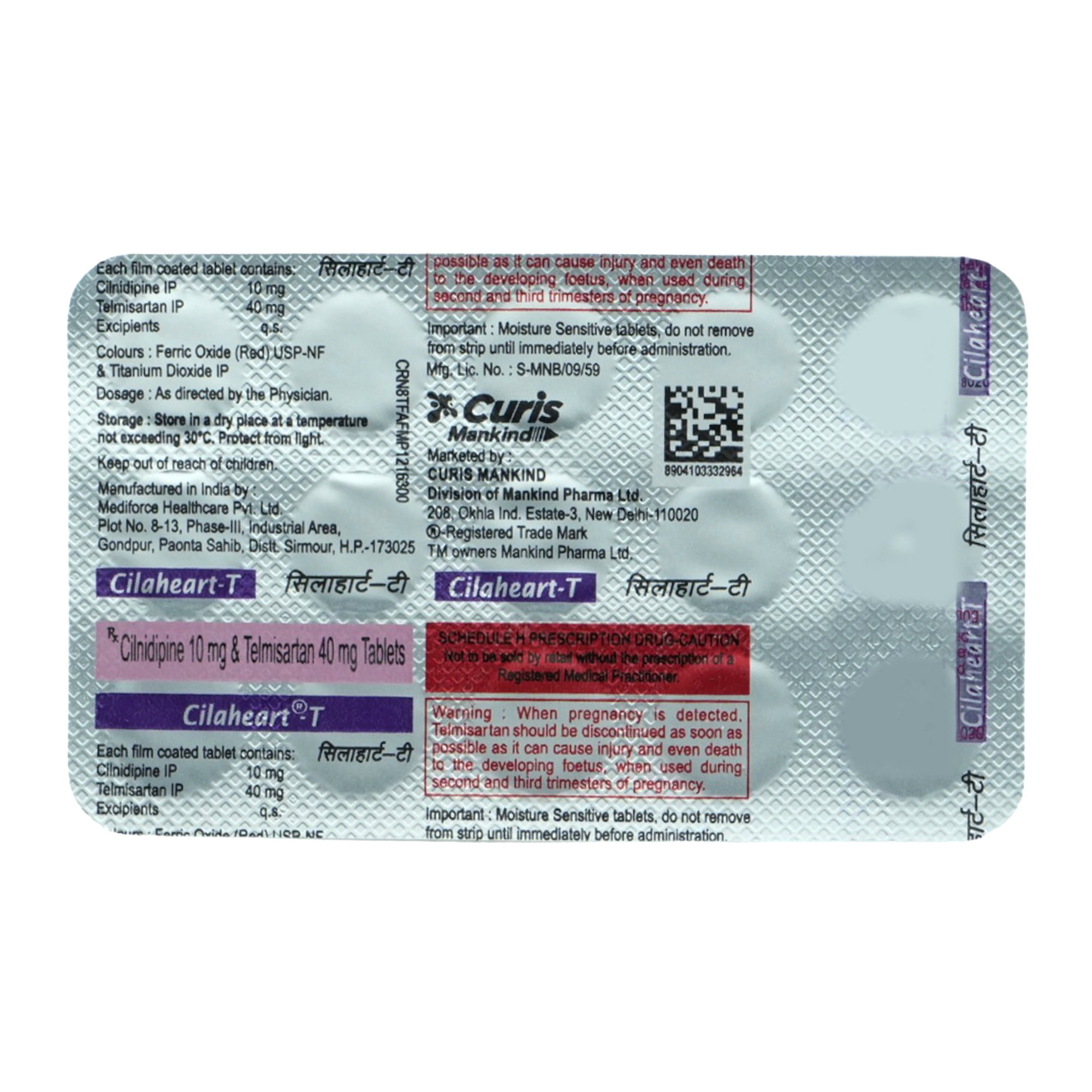
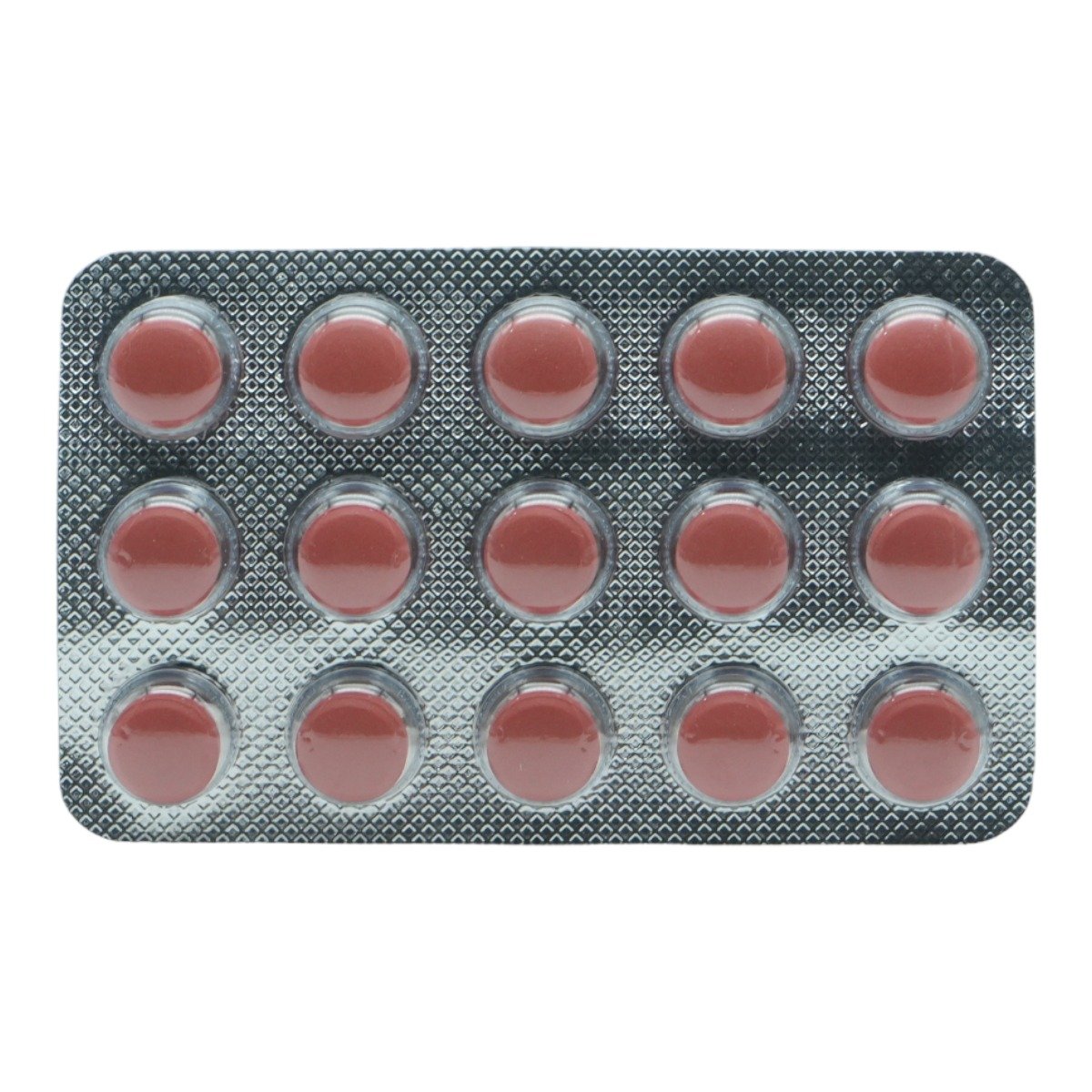
MRP ₹200
(Inclusive of all Taxes)
₹30.0 Cashback (15%)
Selected Pack Size:15
15 ₹180
(₹12 per unit)
In Stock
10 ₹81.9
(₹8.19 per unit)
In Stock
Provide Delivery Location
Online payment accepted
 Prescription drug
Prescription drugWhats That
Composition :
Manufacturer/Marketer :
Consume Type :
Return Policy :
Expires on or after :
About Cilaheart-T 10/40 Tablet
Cilaheart-T 10/40 Tablet belongs to the class of anti-hypertensives primarily taken for the treatment of hypertension (high blood pressure) and heart-related chest pain (angina). It comprises of Cilnidipine (calcium channel blocker) and Telmisartan (angiotensin receptor blocker). Hypertension is a lifelong or chronic condition in which the force exerted by the blood against the artery walls becomes so high that it leads to heart diseases. Angina is chest pain caused by reduced blood flow to the heart.
Cilaheart-T 10/40 Tablet is composed of Cilnidipine and Telmisartan, prescribed to treat hypertension. Cilnidipine blocks the activities of the calcium channels present in the blood vessels of the heart. As a result, the blood vessels widen, and supply to the heart increases, lowering the elevated blood pressure and the workload placed on the heart. Telmisartan works by blocking the action of certain substances that are responsible for tightening the blood vessels. It allows the blood to flow more smoothly and makes the heart more efficient at pumping blood throughout the body. Thus, it reduces the chance of having any heart attack or stroke in the future.
You can take Cilaheart-T 10/40 Tablet with food or without food. It should be swallowed whole with a glass of water. Do not chew, bite, or break it. Your doctor will advise you how often you take your tablets based on your medical condition. Common side effects of Cilaheart-T 10/40 Tablet include sore back, diarrhoea, congested feeling, spinning sensation, soreness in the sinus. Most of these side effects of Cilaheart-T 10/40 Tablet do not require medical attention and gradually resolve over time. However, if the side effects are persistent, reach out to your doctor.
Don't stop taking Cilaheart-T 10/40 Tablet without your doctor advice. Sudden Stopping Cilaheart-T 10/40 Tablet may cause changes in your heart rhythm and blood pressure, cause chest pain, or a heart attack. Your doctor will lower your dose gradually over a period of time to help prevent these symptoms. It is advised to drink plenty of fluids while taking this medicine to overcome dry mouth and extreme thirst. Patients suffering from kidney problems may be required to undergo regular blood creatinine, and potassium levels test as Cilaheart-T 10/40 Tablet affects electrolytes level in our body can be monitored.
Uses of Cilaheart-T 10/40 Tablet
Directions for Use
Medicinal Benefits
Cilaheart-T 10/40 Tablet is composed of Cilnidipine and Telmisartan, prescribed to treat hypertension. Cilnidipine blocks the activities of the calcium channels present in the blood vessels of the heart. As a result, the blood vessels widen, and supply to the heart increases, lowering the elevated blood pressure and the workload placed on the heart. Due to its calcium channel blocking nature it may be also prescribed for relieving the heart’s workload caused due to the heart attack or stroke. Telmisartan works by blocking the action of certain substances that are responsible for tightening the blood vessels. It allows the blood to flow more smoothly and makes the heart more efficient at pumping blood throughout the body. Thus, it reduces the chance of having any heart attack or stroke in the future. Additionally, it has a protective effect on the kidney, and in the condition of diabetes.
Storage
- Hydrate your body: Drink enough water to prevent dehydration and headaches.
- Calm Your Mind: Deep breathing and meditation can help you relax and relieve stress.
- Rest and Recharge: Sleep for 7-8 hours to reduce headache triggers.
- Take rest: lie down in a quiet, dark environment.
- Cold or warm compresses can help reduce tension.
- Stay Upright: Maintain good posture to keep symptoms from getting worse.
- To treat headaches naturally, try acupuncture or massage therapy.
- Over-the-counter pain relievers include acetaminophen and ibuprofen.
- Prescription Assistance: Speak with your doctor about more substantial drug alternatives.
- Severe Headaches: Seek emergency medical assistance for sudden, severe headaches.
- Frequent Headaches: If you get reoccurring headaches, consult your doctor.
- Headaches with Symptoms: Seek medical attention if your headaches include fever, disorientation, or weakness.
- Inform your doctor about dizziness symptoms. They may adjust your medication regimen or prescribe additional medications to manage symptoms.
- Follow your doctor's instructions for taking medication, and take it at the same time every day to minimize dizziness.
- When standing up, do so slowly and carefully to avoid sudden dizziness.
- Avoid making sudden movements, such as turning or bending quickly, which can exacerbate dizziness.
- Drink plenty of water throughout the day to stay hydrated and help alleviate dizziness symptoms.
- If you're feeling dizzy, sit or lie down and rest until the dizziness passes.
- Track when dizziness occurs and any factors that may trigger it, and share this information with your doctor to help manage symptoms.
Drug Warnings
Cilaheart-T 10/40 Tablet should be taken with caution in patients with congestive heart failure, liver disease, peripheral oedema (swelling of hands/legs), cardiogenic shock (when heart suddenly can not pump sufficient blood), recent MI (myocardial infarction) or acute unstable angina (chest pain), severe aortic stenosis (when heart valves become diseased). You should monitor your blood pressure regularly to make sure the Cilaheart-T 10/40 Tablet is working efficiently. Besides this, prolonged intake of Cilaheart-T 10/40 Tablet can lead to lowering of blood pressure (hypotension). So, daily monitoring of blood pressure is advisable.
Drug-Drug Interactions
Drug-Drug Interactions
Login/Sign Up
Using aliskiren together with olmesartan may increase the risk of serious side effects (kidney problems, low blood pressure, and high potassium levels in the blood).
How to manage the interaction:
Taking Cilaheart-T 10 mg/40 mg Tablet with Aliskiren is not recommended as it can cause an interaction, they can be taken if advised by a doctor. You should seek medical attention if you experience nausea, vomiting, weakness, confusion, tingling of the hands and feet, feelings of heaviness in the legs, a weak pulse, or a slow or irregular heartbeat.It is crucial that you continue to consume enough fluids while taking these medications. Do not stop using any medications without consulting a doctor.
Using Cilaheart-T 10 mg/40 mg Tablet with Potassium chloride may increase Potassium levels in the blood.
How to manage the interaction:
Although taking Cilaheart-T 10 mg/40 mg Tablet together with Potassium chloride may lead to an interaction but can be taken if prescribed by the doctor. However, consult the doctor if you experience nausea, vomiting, weakness, disorientation, tingling in your hands and feet, feelings of heaviness in your legs, a weak pulse, or a slow or irregular heartbeat. It is important to maintain proper fluid intake while taking these medications. Do not stop using any medications without talking to a doctor.
Coadministration of Cilaheart-T 10 mg/40 mg Tablet with potassium iodide may increase potassium levels in the blood. (High potassium levels can cause hyperkalemia, which can lead to kidney failure, muscular paralysis, abnormal heart rhythm, and cardiac arrest in extreme cases).
How to manage the interaction:
Although taking Cilaheart-T 10 mg/40 mg Tablet together with potassium iodide may lead to an interaction but can be taken if prescribed by the doctor. However, consult the doctor if you experience nausea, vomiting, weakness, disorientation, tingling in your hands and feet, feelings of heaviness in your legs, a weak pulse, or a slow or irregular heartbeat. It is important to maintain proper fluid intake while taking these medications. Do not stop using any medications without talking to a doctor.
Taking Cilaheart-T 10 mg/40 mg Tablet with trimethoprim may increase potassium levels in the blood.
How to manage the interaction:
Although taking Cilaheart-T 10 mg/40 mg Tablet with trimethoprim may lead to an interaction but can be taken if prescribed by the doctor. However, consult the doctor if you experience nausea, vomiting, weakness, disorientation, tingling in your hands and feet, feelings of heaviness in your legs, a weak pulse, or a slow or irregular heartbeat. Do not stop using any medications without talking to a doctor.
Cilaheart-T 10 mg/40 mg Tablet when combined with benazepril may cause low blood pressure, kidney problems, and may increase potassium levels in the blood.
How to manage the interaction:
Although taking Cilaheart-T 10 mg/40 mg Tablet with benazepril may lead to an interaction but can be taken if prescribed by the doctor. However, consult the doctor if you experience nausea, vomiting, weakness, disorientation, tingling in your hands and feet, feelings of heaviness in your legs, a weak pulse, or a slow or irregular heartbeat. Do not stop using any medications without talking to a doctor.
Taking lithium with Cilaheart-T 10 mg/40 mg Tablet may significantly increase the blood levels of lithium .
How to manage the interaction:
Although taking Cilaheart-T 10 mg/40 mg Tablet alongside lithium can lead to interaction, they can be taken if prescribed by a doctor. However, if you develop sleepiness, dizziness, confusion, loose stools, vomiting, muscular weakness, muscle incoordination, a shaking sensation, blurred vision, ringing in the ears, excessive thirst, and/or increased urination, consult a doctor. Do not stop using any medications without talking to a doctor.
Taking Cilaheart-T 10 mg/40 mg Tablet with triamterene may increase potassium levels in the blood. (High potassium levels can cause hyperkalemia, which can lead to kidney failure, muscular paralysis, abnormal heart rhythm, and cardiac arrest in extreme cases).
How to manage the interaction:
Although taking Cilaheart-T 10 mg/40 mg Tablet with triamterene may lead to an interaction but can be taken if prescribed by the doctor. However, consult the doctor if you experience nausea, vomiting, weakness, disorientation, tingling in your hands and feet, feelings of heaviness in your legs, a weak pulse, or a slow or irregular heartbeat. Do not stop using any medications without talking to a doctor.
When Cilaheart-T 10 mg/40 mg Tablet is taken with captopril, it may cause low blood pressure, kidney problems, and may increase potassium levels in the blood.
How to manage the interaction:
Although taking Cilaheart-T 10 mg/40 mg Tablet with captopril may lead to an interaction but can be taken if prescribed by the doctor. However, consult the doctor if you experience nausea, vomiting, weakness, disorientation, tingling in your hands and feet, feelings of heaviness in your legs, a weak pulse, or a slow or irregular heartbeat. Do not stop using any medications without talking to a doctor.
Coadministration of Cilaheart-T 10 mg/40 mg Tablet with fosinopril may cause low blood pressure, kidney problems, and may increase potassium levels in the blood.
How to manage the interaction:
Although taking Cilaheart-T 10 mg/40 mg Tablet together with fosinopril may lead to an interaction but can be taken if prescribed by the doctor. However, consult the doctor if you experience nausea, vomiting, weakness, disorientation, tingling in your hands and feet, feelings of heaviness in your legs, a weak pulse, or a slow or irregular heartbeat. Do not stop using any medications without talking to a doctor.
Coadministration of Cilaheart-T 10 mg/40 mg Tablet with perindopril may cause low blood pressure, kidney problems, and may increase potassium levels in the blood.
How to manage the interaction:
Although taking Cilaheart-T 10 mg/40 mg Tablet together with perindopril may lead to an interaction but can be taken if prescribed by the doctor. However, consult the doctor if you experience nausea, vomiting, weakness, disorientation, tingling in your hands and feet, feelings of heaviness in your legs, a weak pulse, or a slow or irregular heartbeat. Do not stop using any medications without talking to a doctor.
Drug-Food Interactions
Drug-Food Interactions
Login/Sign Up
Lentils, Orange Juice, Oranges, Raisins, Potatoes, Salmon Dried, Spinach, Tomatoes, Sweet Potatoes, Coconut Water, Beans, Beetroot, Broccoli, Bananas, Apricots, Avocado, Yogurt
How to manage the interaction:
Coadministration of potassium-containing salt substitutes with Olmesartan medoxomil and Cilnidipine may cause high levels of potassium in blood. Avoid potassium-containing salt substitutes while being treated with Olmesartan medoxomil and Cilnidipine.
Diet & Lifestyle Advise
- Keep your weight under control with BMI 19.5-24.9.
- Do regular physical activity or exercise for at least 150 minutes per week, or about 30 minutes most days of the week. Doing this can help you to lower your raised blood pressure by about 5 mm of Hg.
- Opt for diet rich in whole grains, fruits, veggies and low-fat dairy products.
- Limit intake of sodium chloride (table salt) in your daily diet to 2300 mg per day or less than 1500 mg is ideal for most adults.
- If you are taking alcohol then only one serving for women and two servings for men is advisable.
- Quitting smoking is the best strategy to lower the risk of heart disease.
- Avoid chronic stress as it can raise your blood pressure. Try to enjoy and spent time with your loved ones to cope with stress and practice mindfulness techniques.
- Monitor your blood pressure daily and if there is too much of fluctuation then immediately contact your doctor.
- Try to include heart healthy omega 3 fatty acid containing food drinks in your daily diet. You can also use low fat cooking oil like olive oil, soybean oil, canola oil, and coconut oil can help in lowering your elevated blood pressure.
Side Effects of Cilaheart-T 10/40 Tablet
- Sore back
- Diarrhoea
- Congested feeling
- Spinning sensation
- Soreness in the sinus
Habit Forming
Therapeutic Class
All Substitutes & Brand Comparisons
RX
Telvas-LN 40 Tablet 10's
Aristo Pharmaceuticals Pvt Ltd
₹106.5
(₹9.59 per unit)
20% CHEAPERRX
Cortel LN Tablet 15's
Corona Remedies Pvt Ltd
₹163
(₹9.78 per unit)
18% CHEAPERRX
Nulong-T 40/10 Tablet 15's
Micro Labs Ltd
₹173
(₹10.39 per unit)
13% CHEAPER
Product Substitutes
Drug-Diseases Interactions
Drug-Diseases Interactions
Login/Sign Up
FAQs
It is advised to continue your medicine even after your blood pressure is under control or becomes normal as blood pressure can shoot up any time. If you have persistent headache, please consult your doctor immediately.
If you miss a dose of Cilaheart-T 10/40 Tablet , you are advised to take it as soon as you remember. Do not double the dose as it may lead to lowering of blood pressure. Take one daily at the same time.
High blood pressure in the stage of pregnancy may cause eclampsia that can be harmful for both baby and mother. So, during the pregnancy you should have regular blood pressure monitoring.
No, it is a prescribed drug, given by a physician for preventing specific medical conditions. Taking it on your own can cause unwanted side-effects.
Yes, Cilaheart-T 10/40 Tablet can cause dizziness. It is advised to avoid driving or operate any heavy machinery while taking Cilaheart-T 10/40 Tablet . In case you feel dizzy or lightheaded, it is advised to rest for some time until you feel better.
Drug-Drug Interactions Checker List
- QUINIDINE
- PHENYTOIN
- RIFAMPICIN+ISONIAZID
- ERYTHROMYCIN
- LITHIUM
Special Advise
Sudden withdrawal may worsen angina (chest pain). However, if ou experience chest pain, consult your doctor immediately.
Disease/Condition Glossary
Blood pressure: It is the measurement of the force that our heart uses to pump blood to all parts of the body. Hypertension is a chronic condition when blood pressure is too high. This condition can lead to hardened arteries (blood vessels), decreasing the blood and oxygen flow to the heart. Raised blood pressure can cause chest pain (angina) and heart attack (when blood supply to the heart is blocked). Additionally, high blood pressure also causes brain damage (stroke) and kidney failure. High blood pressure can be diagnosed with the help of a blood pressure monitor or sphygmomanometer. Systolic pressure is the pressure when the heart pumps blood out. On the other hand, diastolic pressure is the pressure when your heart is at the resting stage between heartbeats. If your blood pressure is 140/90 mm of Hg, it means the systolic pressure is 140 mm of Hg and, diastolic pressure is 90 mm of Hg. Ideal blood pressure should be between 90/60 mm of Hg and 120/80 mm of Hg.

Have a query?
Buy best Cardiology products by
Torrent Pharmaceuticals Ltd
Sun Pharmaceutical Industries Ltd
Lupin Ltd
Intas Pharmaceuticals Ltd
Cipla Ltd
Micro Labs Ltd
Macleods Pharmaceuticals Ltd
Abbott India Ltd
Ajanta Pharma Ltd
Ipca Laboratories Ltd
Eris Life Sciences Ltd
Mankind Pharma Pvt Ltd
Lloyd Healthcare Pvt Ltd
Dr Reddy's Laboratories Ltd
Glenmark Pharmaceuticals Ltd
Emcure Pharmaceuticals Ltd
Alembic Pharmaceuticals Ltd
Alkem Laboratories Ltd
East West Pharma India Pvt Ltd
USV Pvt Ltd
Zydus Healthcare Ltd
Aristo Pharmaceuticals Pvt Ltd
Elbrit Life Sciences Pvt Ltd
J B Chemicals & Pharmaceuticals Ltd
Zydus Cadila
Akumentis Healthcare Ltd
Alteus Biogenics Pvt Ltd
Hbc Life Sciences Pvt Ltd
Fusion Health Care Pvt Ltd
Troikaa Pharmaceuticals Ltd
La Renon Healthcare Pvt Ltd
Corona Remedies Pvt Ltd
Jubilant Lifesciences Ltd
Medley Pharmaceuticals Ltd
Knoll Healthcare Pvt Ltd
Msn Laboratories Pvt Ltd
Zuventus Healthcare Ltd
Cadila Pharmaceuticals Ltd
Blue Cross Laboratories Pvt Ltd
Lividus Pharmaceuticals Pvt Ltd
Morepen Laboratories Ltd
Ranmarc Labs
Shrrishti Health Care Products Pvt Ltd
Sanofi India Ltd
Steris Healthcare
Elder Pharmaceuticals Ltd
Primus Remedies Pvt Ltd
Unison Pharmaceuticals Pvt Ltd
Eswar Therapeutics Pvt Ltd
Knoll Pharmaceuticals Ltd
Tas Med India Pvt Ltd
Systopic Laboratories Pvt Ltd
Indiabulls Pharmaceuticals Pvt Ltd
Leeford Healthcare Ltd
Sinsan Pharmaceuticals Pvt Ltd
Biochem Pharmaceutical Industries Ltd
Cadila Healthcare Ltd
Azkka Pharmaceuticals Pvt Ltd
Nirvana India Pvt Ltd
Orsim Pharma
Prevego Healthcare & Research Pvt Ltd
Econ Healthcare
Elinor Pharmaceuticals (P) Ltd
FDC Ltd
Sunij Pharma Pvt Ltd
Nicholas Piramal India Ltd
Astra Zeneca Pharma India Ltd
Pfizer Ltd
Lia Life Sciences Pvt Ltd
Shine Pharmaceuticals Ltd
Elicad Pharmaceuticals Pvt Ltd
Indoco Remedies Ltd
Proqol Health Care Pvt Ltd
Vasu Organics Pvt Ltd
Biocon Ltd
Opsis Care Lifesciences Pvt Ltd
Johnlee Pharmaceuticals Pvt Ltd
Merck Ltd
Wockhardt Ltd
Auspharma Pvt Ltd
Ergos Life Sciences Pvt Ltd
Lakshya Life Sciences Pvt Ltd
Ordain Health Care Global Pvt Ltd
Pficus De Med Pvt Ltd
ALICAN PHARMACEUTICAL PVT LTD
RPG Life Sciences Ltd
Glynis Pharmaceuticals Pvt Ltd
Orris Pharmaceuticals
Samarth Life Sciences Pvt Ltd
Aprica Pharmaceuticals Pvt Ltd
Aretaeus Pharmaceuticals Pvt Ltd
Koye Pharmaceuticals Pvt Ltd
Neocardiab Care
Retra Life Science Pvt Ltd
Alniche Life Sciences Pvt Ltd
Alvio Pharmaceuticals Pvt Ltd
Arkas Pharma Pvt Ltd
Atos Lifesciences Pvt Ltd
Divine Savior Pvt Ltd
Metalis Lifesciences Pvt Ltd
Alcohol
Unsafe
Cilaheart-T 10/40 Tablet can lower your blood pressure causing dizziness and drowsiness. It can also cause orthostatic hypotension (sudden fall in blood pressure while standing). So try to avoid intake of Cilaheart-T 10/40 Tablet with alcoholic beverages.
Pregnancy
Caution
There are no clinical data on the safety of Cilaheart-T 10/40 Tablet during pregnancy. So, it should be taken with caution.
Breast Feeding
Caution
Nursing mother should consult doctor before taking Cilaheart-T 10/40 Tablet .
Driving
Unsafe
Cilaheart-T 10/40 Tablet may cause side effects which could affect your ability to drive. Taking Cilaheart-T 10/40 Tablet may lower your blood pressure
Liver
Caution
There is limited information available on the use of Cilaheart-T 10/40 Tablet in patients with liver disease. So Cilaheart-T 10/40 Tablet should be taken with caution and with consultation to doctor only.
Kidney
Safe if prescribed
Cilaheart-T 10/40 Tablet is probably safe to use in patients with kidney disease. It has shown beneficial and protective effect on the kidney.
Children
Safe if prescribed
The safety and effectiveness of Cilaheart-T 10/40 Tablet has not been established in children due to limited testing of this drug on children by competent authorities across the world. Hence, it is best to consult a child specialist.
Recommended for a 30-day course: 2 Strips


